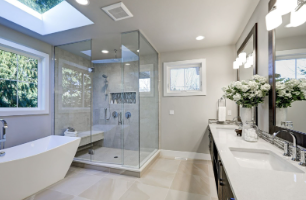
If you're getting ready to remodel your bathroom and replace an outdated shower, you’ll find no shortage of options to choose from. Two of the most popular choices are standard showers and walk-in showers—each offering its own set of benefits and potential drawbacks.
To help you make the right choice for your space and lifestyle, here’s a breakdown of the pros and cons of both styles and what to consider when deciding which one is the best fit for your home.
What Are the Pros of Walk-in Showers?
- Enhanced Accessibility
Walk-in showers offer easier entry and exit, making them ideal for aging individuals or those who use wheelchairs. Their low or zero-threshold entry minimizes the risk of slips and falls. - Modern Aesthetic Appeal
These showers provide a sleek, contemporary look that elevates your bathroom's interior design. Glass panels and open layouts enhance light flow and create the illusion of more space. - Efficient Use of Space
Walk-in showers are perfect for smaller bathrooms or a basement remodel where a compact floor plan is needed. They eliminate bulky fixtures and often replace the need for a full bathtub. - Easy Maintenance
The open design allows for quicker cleaning and reduces mildew buildup. With fewer nooks and crannies, soap scum and mold are less likely to accumulate. - Customization Potential
Walk-in showers can be tailored with tile patterns, grab bar placements, and unique layouts for a truly personalized bathing experience. Their design flexibility suits any renovation project.
What Are the Cons of Walk-in Showers?
- Higher Initial Cost
Because of customization costs and additional waterproofing requirements, walk-in showers can exceed a typical bathroom renovation budget. Additionally, the complexity of installation may also affect plumbing needs. - Water Splash Concerns
Without a curtain or full enclosure, water can splash onto the floor and increase the potential for water damage. Proper drainage is essential to prevent puddling. - Reduced Warmth
The open design may not retain steam as well as enclosed standard showers, leading to a cooler experience. This can be a downside for users who enjoy long, hot showers. - Less Privacy
While stylish, the glass walls of a walk-in shower offer limited privacy. This might not suit shared bathrooms or family settings where visual separation is valued. - Limited Bathtub Functionality
A walk-in design excludes the traditional bathtub, which can be an issue for families with children who need tub bathing.
What Are the Pros of Standard Showers?
- More Contained Water Control
Standard showers do a better job of keeping water inside. This, naturally, reduces the risk of floor water damage. - Improved Heat Retention
Enclosures trap steam and help maintain warmth during bathing. This creates a more comfortable shower experience in colder climates. - Greater Affordability
These showers are typically less expensive to install, making them a better fit for a tight home improvement budget. They often use prefabricated units, which help lower construction time. - Added Storage Options
Standard designs may include built-in shelves or wall-mounted features for holding soap, shampoo, and other products. - Bathtub Combination Available
Many standard setups include a bathtub, making them versatile for families or individuals who enjoy both soaking and showering. This dual-purpose option adds greater flexibility.
What Are the Cons of Standard Showers?
- Limited Accessibility
High tub walls or narrow entryways can pose challenges for people with mobility issues. They are less suitable for homes focused on aging in place or universal design. - Outdated Appearance
Standard showers may not align with current aesthetics in modern bathroom design. Their look can appear dated, especially if fixtures or tiles are worn. - More Prone to Mold
Enclosed spaces with poor ventilation encourage mold and mildew growth. Proper airflow and regular cleaning are necessary to maintain health and hygiene. - Space Consumption
A bathtub-shower combo can take up more space than a walk-in alternative. This reduces usable floor area, which matters in compact bathrooms. - Difficult Repairs
Standard units often involve more complicated plumbing and construction when upgrades or maintenance are needed. Accessing pipes behind walls can increase repair complexity.
How Can You Determine Which Shower Type Is Better for Your Home?
- Evaluate Your Bathroom’s Floor Plan
Consider how much space you have and where the shower will be located in relation to the window, toilet, and sink. For example, tight layouts benefit from walk-in options that open up the floor visually. - Think About Long-Term Needs
If accessibility is a priority, walk-in showers with grab bars offer future-ready comfort. Additionally, families with young children may prefer a traditional bathtub for more flexible bathing needs. - Assess Your Budget and Timeframe
Standard showers generally cost less and involve simpler construction. Walk-in showers might be a more worthwhile investment if your renovation goals are to increase resale value. - Factor in Water Conservation and Ventilation
Walk-in showers often use less water but need better ventilation to prevent mold.
- Align the Choice With Your Style Preference
Walk-in showers have a more modern aesthetic thanks to their open glass layouts and elegant tile work. Traditional showers, meanwhile, better match classic interiors and may feel cozier and more private.
Call Benjamin Franklin Plumbing® to Plan Your Shower Installation
Whether you've decided on a standard or walk-in shower, we'll have your back. Benjamin Franklin Plumbing® specializes in shower installations in Levittown and can also perform shower repairs as needed to make sure you can always bathe in a safe and functional shower.
Reach out today to learn more and to discuss your shower project with our team!

 Your Privacy Choices
Your Privacy Choices